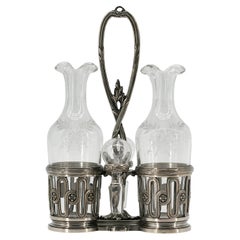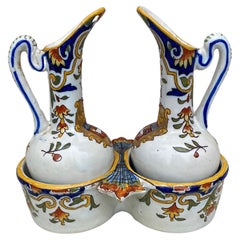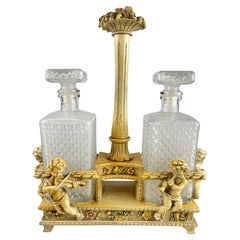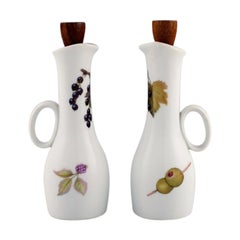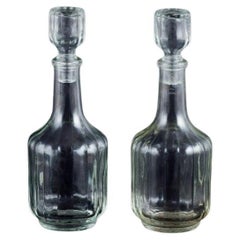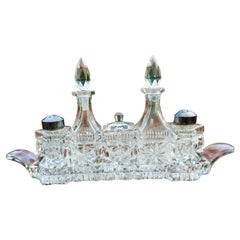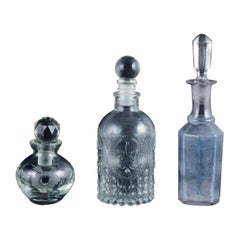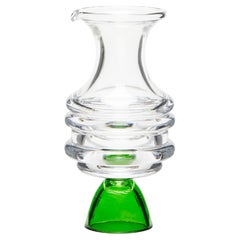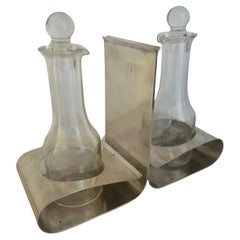Oil Vinegar
to
34
201
110
179
86
61
53
53
34
31
30
26
25
23
16
16
15
14
14
13
11
10
8
8
8
5
5
5
4
3
3
2
2
2
2
2
1
1
1
1
1
1
1
1
1
6
6
5
5
5
Sort By
CHRISTOFLE Silverplate Oil & Vinegar Set, 1900
By Christofle
Located in Saint-Amans-des-Cots, FR
Silverplate oil & vinegar set by CHRISTOFLE, France, ca.1900. Silverplate and crystal. Height: 8.7
Category
Antique Early 1900s French Napoleon III Sheffield and Silverplate
Materials
Crystal, Silver Plate
Set of French Faience Oil & Vinegar Pitcher & Holder Desvres
By Desvres
Located in Austin, TX
Set of French Faience Oil & Vinegar Pitcher & Holder Desvres.
Category
Antique Early 1900s French Rustic Pitchers
Materials
Faience
Table Set For Oil/Vinegar Bottles, Italy, 1960s
Located in Palermo, IT
Table set for oil/vinegar bottles, Italy, 1960s
The bottle holder is ivorine. Ivorine has also been
Category
Vintage 1960s Italian Tableware
Materials
Glass
Royal Worcester, England. Evesham Oil / Vinegar Set in Porcelain
Located in København, Copenhagen
Royal Worcester, England. Evesham oil / vinegar set in porcelain decorated with fruits. Cork in
Category
Vintage 1980s English Porcelain
Materials
Porcelain
Oil/vinegar set in clear glass. Danish design. 1930s/40s.
Located in København, Copenhagen
Oil/vinegar set in clear glass. Danish design.
1930s/40s.
In excellent condition.
Marked STO
Category
Vintage 1930s Danish Tableware
Materials
Glass
Oil vinegar salt and pepper set attributed to ABP cut glass
By Val Saint Lambert, Bohemia
Located in Lugo, IT
Oil vinegar salt and pepper set attributed to ABP cut glass.
1900?
Breaked cap as per photo
Thanks
Category
Antique Early 1900s American Tableware
Materials
Cut Glass
Danish glassworks, three oil/vinegar jugs in different designs. 1930/40s
Located in København, Copenhagen
Danish glassworks, three oil/vinegar jugs in different designs. Clear glass.
1930/40s.
In excellent
Category
Vintage 1930s Danish Tableware
Materials
Glass
$360 / set
H 7.49 in Dm 1.97 in
Contemporary Oil Vinegar Blown Green Glass Server Handcrafted by Natalia Criado
By Natalia Criado
Located in Milan, IT
artisans. Each piece is a testament to the traditional craftsmanship. Perfect for serving oil, vinegar, or
Category
2010s Italian Modern Tableware
Materials
Blown Glass
$231 Sale Price / item
20% Off
H 3.94 in W 3.15 in D 3.15 in
Lino Sabattini Modern Oil & Vinegar Set, c. 1970's
By Lino Sabattini
Located in Ross, CA
Modern style Oil & Vinegar table set designed by Sabattini in Italy, made in the 1970's or 1980's
Category
Vintage 1970s Italian Modern Sheffield and Silverplate
Materials
Silver Plate
$280 Sale Price / set
20% Off
H 7.5 in W 9.25 in D 3.75 in
20th Century Oil Vinegar and Mustard Serving Set Mounted Porcelain
Located in Miami, FL
Stylish 20th century oil, vinegar cruets or serving bottles with a mustard dish in good quality
Category
20th Century French Mid-Century Modern Barware
Materials
Silver Plate
Antique De Klauw Delft Oil & Vinegar Blue & White Deftware Plates, ca 1700
Located in Amsterdam, Noord Holland
Antique De Klauw Delft Oil & Vinegar Blue & White Deftware Plates, ca 1700. Very nice set
Category
Antique 17th Century Chinese Pitchers
Materials
Porcelain
$639 Sale Price
20% Off
W 6.5 in
1920 This Shelf w/ Porcelain Drawers for Spices Sugar Flower Oil Vinegar Coffee
Located in Schöfflisdorf, CH
1920 This shelf with porcelain drawers for spices sugar flower oil vinegar coffee rice
ect. 8 Big
Category
Vintage 1920s Czech Art Deco Shelves
Materials
Ceramic, Wood
$2,978 / set
H 16.15 in W 31.89 in D 7.09 in
French Faience Oil & Vinegar Pitchers
Located in Austin, TX
Pair of antique French faience oil and vinegar pitchers, circa 1900. Unsigned. Minors chips
Category
Antique Early 1900s French Country Pitchers
Materials
Faience
Angelo Mangiarotti for Vilca Crystal Italy Olive Oil Vinegar Table Top Set
By Ambrogio Pozzi, Angelo Mangiarotti, Cristalleria ColleVilca
Located in North Hollywood, CA
Angelo Mangiarotti for Vilca Crystal Italy Olive Oil Vinegar Table Top Set on Tray.
7 pieces set
Category
Late 20th Century Italian Post-Modern Serving Pieces
Materials
Crystal
$495 / item
H 7 in W 9 in D 4 in
70s Bohemian Bamboo Wood Rectangle Spice Oil Vinegar Serving Tray Caddy Leather
Located in Miami, FL
Kitchen Serving Tray, Spice Rack or Breakfast Platter.
The Storage Tray provides 3 compartments for Oil
Category
Late 20th Century American Bohemian Platters and Serveware
Materials
Leather, Bamboo, Wood
$395
H 3.38 in W 21.75 in D 8 in
Rare Vintage Heath Ceramics Oil & Vinegar Set
By Heath Ceramics
Located in San Juan Capistrano, CA
This is a rare Heath Ceramics Oil and Vinegar Set. Both bottles have their original stoppers and
Category
Vintage 1970s American Mid-Century Modern Pottery
Materials
Ceramic
Postmodern Ettore Sottsass Model 5074 Oil & Vinegar Set for Alessi, Italy 1978
By Memphis Milano, Ettore Sottsass, Memphis Group, Alessi
Located in London, GB
For sale is the iconic Postmodern 'Model 5074' Oil & Vinegar set, designed by Ettore Sottsass and
Category
Late 20th Century Italian Post-Modern Serving Pieces
Materials
Steel, Stainless Steel, Chrome
$226
H 7.49 in W 6.89 in D 3.15 in
Glass Condiment Oil Vinegar Set Ruby Red Silver Vintage Vienna Made 1854
By Viennese Manufactory
Located in Vienna, AT
________________________________________________________________________________
Measures:
1) height of oil & vinegar bottle: 22.0 cm / 8.66 inches
2) height of pepper & sa...
Category
Antique 1850s Austrian Early Victorian Glass
Materials
Silver
$1,131 / set
H 8.66 in Dm 1.77 in
Antique French Crystal Cruet Set, Oil & Vinegar Service
Located in Miami, FL
Elegant Early 20th century French Art Deco style crystal oil and vinegar cruets or serving bottles
Category
Early 20th Century French Art Deco Barware
Materials
Crystal
French LXVI Silver Serving Set Oil Vinegar Old Man’s Silver Hallmark
Located in Miami, FL
Exquisite set of oil and Vinegar LXVI Silver and cristal.
Neo classic design animal and winged
Category
Antique Early 19th Century French Louis XVI Serving Pieces
Materials
Silver
19th Century French Faience Quimper Oil & Vinegar Pitchers Cruet Set & Stand
By Henriot Quimper
Located in Pearland, TX
A charming 19th Century French Quimper faience oil and vinegar handled jugs cruet set and
Category
Antique Late 19th Century French Delft and Faience
Materials
Faience
$625
H 6 in W 6.25 in D 4 in
Lino Sabattini rare cruet , oil/vinegar container set , attb to Christofle
By Lino Sabattini, Christofle
Located in Los Angeles, CA
Great set designed by LINO SABATTINI in stainless steel and glass, with acrylic stopper .Glass marked as well.
Category
Late 20th Century Italian Post-Modern Tableware
Materials
Stainless Steel
Antique Cut Crystal Sterling Silver Oil Vinegar Cruet Set 1825 George Piercy
Located in Dublin, Ireland
Stunning Pair of English Hand Cut Crystal and Sterling Silver Oil and Vinegar Cruet Set of
Category
Antique Early 19th Century English George IV Tableware
Materials
Sterling Silver
$1,042 / set
H 9 in W 3 in D 3 in
Jørgen Møller Complet Service Tray Set, Oil & Vinegar Bottles and Mustard Bowl
By Royal Copenhagen, Jorgen Moller
Located in Miami, FL
service tray with handle, oil bottle, vinegar bottle, mustard bowl and stainless steel spoon.
Category
Late 20th Century Danish Modern Serving Bowls
Materials
Steel
$375 / set
H 7.5 in W 6 in D 6 in
Art Deco Swan Oil & Vinegar Stand by C. Fjerdingstad, Gallia for Christofle
By Christian Fjerdingstad, Christofle, Gallia
Located in Paris, FR
Swan-shaped silverplated oil and vinegar stand with two small Baccarat crystal bottles with canted
Category
Vintage 1920s French Art Deco Tableware
Materials
Crystal, Metal
$3,276
H 6.7 in W 5.71 in D 3.55 in
Mid-Century Italian Ceramic Oil & Vinegar Cruet Set by Franco Pozzi, Italy 1970s
Located in Roma, IT
design
The set includes an oil dispenser, a vinegar dispenser and a salt and pepper shaker. Completed by
Category
Vintage 1970s Italian Mid-Century Modern Ceramics
Materials
Ceramic, Beech
$738 / set
H 8.67 in W 7.49 in D 4.34 in
Mid 20th Century Vintage MCM Arni Form Condiment Lazy Susan- 7 Pieces
Located in West Palm Beach, FL
the bottom. Oil and vinegar, salt and pepper and sugar bowl all on top of a rotating lazy susan
Category
Mid-20th Century Italian Serving Pieces
Materials
Ceramic, Teak
$895 / set
H 10 in W 8 in D 8 in
Set of 46 pcs Vintage Table Accessories, Made in Italy, 1970s
Located in Palermo, IT
coasters, 1 oil/vinegar dispenser, 1 breadstick holder.
There is a seal from the Emporio Roma, the best
Category
Vintage 1970s Italian Tray Tables
Materials
Steel
$1,072 / set
H 1.19 in W 20.87 in D 14.97 in
Mid-Century Modern Menage Set Made of Ceramic and Olive Wood
Located in Doornspijk, NL
This set can rightfully be called tasteful as it offers space for oil, vinegar, salt, pepper and
Category
Mid-20th Century Dutch Mid-Century Modern Tableware
Materials
Ceramic, Wood
Antique French Cut Glass and Metal Oil and Veniger Cruet Set, 19th Century
Located in Rostock, MV
This antique "Oil & Vinegar" cruet set, dating to the late 19th century, is a superb example of
Category
Antique 19th Century French Glass
Materials
Metal
$3,872
H 11.82 in W 8.86 in D 4.53 in
Paul Storr Sterling Silver and Cut Glass Cruet Service
By Paul Storr
Located in Jesmond, Newcastle Upon Tyne
/vinegar bottles and four small oil / vinegar bottles displayed on the original Stand.
The original
Category
Antique Early 1800s English Georgian Centerpieces
Materials
Silver, Sterling Silver
Mid Century Stainless Steel Condiment Set Stella, Italy, 1970s, Set of 6 Pieces
By Stella
Located in San Benedetto Del Tronto, IT
comprises five distinct containers for oil, vinegar, salt, pepper, and toothpicks, each featuring the
Category
Vintage 1970s Italian Mid-Century Modern Serving Pieces
Materials
Stainless Steel
$464
H 7.88 in W 7.09 in D 5.91 in
Strawberries and Vinegar, Painting, Oil on Canvas
By Linda Yurgensen
Located in Yardley, PA
This painting is a delightful little still life with texture and color. It would look lovely in a country kitchen. The sides of the slim canvas have been painted and the back is wir...
Category
2010s Impressionist Still-life Paintings
Materials
Oil
Arzberg Oil and Vinegar Serving Bottles, 1980
By Arzberg
Located in Los Angeles, CA
Wonderful white porcelain oil and vinegar serving bottles by Arzberg, Germany, with cork caps
Category
Vintage 1980s German Post-Modern Serving Pieces
Materials
Porcelain, Cork
A George II Style Silver Plated Warwick Cruet
Located in Brighton, West Sussex
, and a number of cruet bottles for serving liquid condiments, like oil, vinegar and soy. Additionally
Category
Antique 19th Century English George II Serving Pieces
Materials
Silver Plate
Cini & Nils Oil and Vinegar Cruet Set
By Cini & Nils
Located in Sheffield, MA
A masterfully designed modernist oil and vinegar cruet set of impeccable quality made of glass and
Category
Vintage 1970s Italian Mid-Century Modern Serving Pieces
Materials
Stainless Steel
Santucci Deruta Oil and Vinegar Majolica with Raphaelesque
By Deruta
Located in Lugo, IT
Santucci Deruta Oil and Vinegar Majolica with Raphaelesque decoration.
Good condition.
Thanks
Category
Vintage 1980s Italian Tableware
Materials
Maiolica
Vintage Glass and Faience Condiment Set with Floral "China" Design - 2Y246
Located in Bordeaux, FR
containers for oil, vinegar, salt, and pepper, each with intricate floral decorations. While the set is in
Category
20th Century Unknown Antiquities
Materials
Faience, Glass
$166 Sale Price / set
65% Off
H 3.55 in Dm 1.58 in
18th Century Polychrome Delft Oil and Vinegar Stand
Located in Haddonfield, NJ
18th Century polychrome Delft oil and vinegar stand in Imari flower decorations.
Category
Antique Mid-18th Century Dutch Baroque Delft and Faience
Materials
Delft
Lalique Crystal Bangkok Oil and Vinegar Cruet Set
By Lalique
Located in Guaynabo, PR
This set of oil and vinegar crystal bottles are decorated with a basket weave design in the lower
Category
Early 20th Century French Art Deco Crystal Serveware
Materials
Crystal
$460 Sale Price / set
20% Off
H 5.38 in W 5 in D 4.25 in
20th Century Italian Art Nouveau - Liberty replica Sterling Silver - Cruet Set
Located in VALENZA, IT
Set of Art Nuoveau - Liberty replica of oil cruet, parmesan bowl and salt/pepper in 925 Sterling
Category
Vintage 1970s Italian Art Nouveau Sterling Silver
Materials
Sterling Silver
$5,361 / set
H 8.27 in W 11.03 in D 3.94 in
Art Deco Vinegar and Oil Cut Class Around 1920s
Located in Wien, AT
Art Deco vinegar and oil cut class around 1920s
Original condition.
Category
Vintage 1920s Austrian Art Deco Tableware
Materials
Cut Glass
Vintage Silver Plated Cruet Set with Cut and Beveled Crystal Glass Bottles, 50s
Located in Roma, IT
racks including containers for pepper, salt or mustard and 2 cruets with stops for oil, vinegar and more
Category
Mid-20th Century Italian Mid-Century Modern Sheffield and Silverplate
Materials
Crystal, Silver Plate
$464
H 9.06 in Dm 6.7 in
Set of Italian 18th century Oil and Vinegar Flacons
Located in Vosselaar, BE
A set of handblown early 18th century Oil and Vinegar Flacons. Following the French Court etiquette
Category
Antique Early 18th Century Italian Baroque Glass
Materials
Glass
Christian Dior blond tortoiseshell oil and vinegar glass cruet, Italy 1960s
By Christian Dior
Located in Milan, IT
Christian Dior blond tortoiseshell oil and vinegar glass cruet, Italy 1960s
Category
Vintage 1960s Italian Mid-Century Modern Tableware
Materials
Brass
$524
H 6.78 in W 7.09 in D 3.35 in
Oil and Vinegar Cruet Set Mid-Century Design Italy 1970s Vintage
Located in Palermo, IT
A masterfully designed modernist oil and vinegar cruet set of impeccable quality made of glass and
Category
Mid-20th Century Italian Mid-Century Modern Serving Pieces
Materials
Crystal, Silver Plate
Oil and Vinegar Set in 800 Silver and Crystal, Italy, 1990
Located in Palermo, IT
Oil and vinegar set in 800 silver and crystal, Italy, 1990
Intact, never used. Small signs of
Category
1990s Italian Sterling Silver
Materials
Crystal, Silver
$619 Sale Price
25% Off
H 8.67 in W 7.09 in D 2.56 in
Michael Bang for Holmegaard. Oil and Vinegar Containers in Art Glass
Located in København, Copenhagen
Michael Bang for Holmegaard.
Oil and vinegar containers in orange and white art glass.
1960s.
In
Category
Vintage 1960s Danish Scandinavian Modern Glass
Materials
Art Glass
18th Century German Silver Oil and Vinegar Bottle Cruet Set
Located in New York, NY
Continental silver cruet, most likely German and from the 18th century, with exquisite pierced work and cartouches with engraved monograms, standing on 4 animal-shaped feet, with 2 g...
Category
Antique 18th Century German Tableware
Materials
Silver
$1,950 / set
H 11.5 in W 7.25 in D 3.13 in
Oil and Vinegar Cruet in Silver Plated Metal and Crystal, 19th Century.
Located in Saint-Ouen, FR
Oil and vinegar cruet in silver plated metal and crystal, 19th century.
Napoleon III period oil
Category
Antique 19th Century French Napoleon III Crystal Serveware
Materials
Crystal, Silver Plate
$1,548
H 11.03 in W 9.45 in D 3.94 in
Oil and Vinegar Cruet in Silver Plated Metal and Crystal, 19th Century.
Located in Saint-Ouen, FR
Oil and vinegar cruet in silver plated metal and crystal, 19th century.
Napoleon III period oil
Category
Antique 19th Century French Napoleon III Crystal Serveware
Materials
Crystal, Silver Plate
$1,489
H 9.85 in W 9.85 in D 3.94 in
Bubble Oil and Vinegar Dispenser Set in Blown Glass by Gordon Guillaumier
By Gordon Guillaumier
Located in Milan, IT
Bubble, designed by Gordon Guillaumier, is an oil and vinegar dispenser set made in transparent
Category
2010s Italian Modern Tableware
Materials
Blown Glass, Cork
$125 / set
H 6.7 in Dm 3.35 in
French 19th Century Double Handled Brown Glaze Pottery Jug with Rustic Character
Located in Atlanta, GA
, diligently holding various liquids like oil, vinegar, water, or cider. The jug's history of everyday use is
Category
Antique 19th Century French Rustic Jars
Materials
Pottery
$475
H 14 in Dm 9.5 in
19th Century Italian Milanese Neoclassical Silver Oil and Vinegar Cruet Set
Located in Milano, MI
Antique Milanese silver oil cruet consisting of an oval tray supported by four cast zoomorphic paw
Category
Antique Mid-19th Century Italian Neoclassical Sterling Silver
Materials
Silver
$2,144
H 10.63 in W 8.67 in D 4.73 in
Il Pino Barletta , 1950s Vinegar and Oil Set Container, Hand-Decorated Ceramic
Located in Vigonza, Padua
ancora”, così Barletta ha ricordato il suo gigante secolare
Mid-Century Modern, vinegar and oil set
Category
Mid-20th Century Italian Mid-Century Modern Ceramics
Materials
Ceramic
$1,906 / set
H 6.7 in W 1.97 in D 3.55 in
Set of 3 Vintage German Oil and Vinegar Tray Menagere from WMF, 1970s
Located in Hamburg, DE
Vintage German Oil and Vinegar Tray Menagere from WMF, 1970s, Set of 3, in Very Good conditions
Category
20th Century German More Dining and Entertaining
Materials
Metal
$352 / set
H 6.69 in W 7.48 in D 3.15 in
1890s Antique French Salins Creamware Cruet Set Oil and Vinegar Set- 3 Pieces
By Salins
Located in Waxahachie, TX
Antique French Salins Creamware Cruet Set Oil and Vinegar Set Circa 1890, Beautiful.
Unusual to
Category
Antique 1890s French Victorian Tableware
Materials
Crystal
$192 Sale Price
44% Off
H 11.5 in W 8 in D 4 in
Art Nouveau Cruet Glass Two Bottle Vinegar & Oil Set Antique European, 1900s
Located in Nuernberg, DE
Continental silver plated cruet, most likely English or Italian and dating to the early 20th century. Exquisitely crafted and with an engraved rim around the base, standing on 4 anim...
Category
Antique Early 1900s Italian Art Nouveau Sheffield and Silverplate
Materials
Metal, Silver Plate
$300
H 11.13 in W 9 in D 4 in
- 1
Get Updated with New Arrivals
Save "Oil Vinegar", and we’ll notify you when there are new listings in this category.
Oil Vinegar For Sale on 1stDibs
With a vast inventory of beautiful furniture at 1stDibs, we’ve got just the oil vinegar you’re looking for. Each oil vinegar for sale was constructed with extraordinary care, often using metal, silver and glass. There are 47 variations of the antique or vintage oil vinegar you’re looking for, while we also have 3 modern editions of this piece to choose from as well. Your living room may not be complete without an oil vinegar — find older editions for sale from the 18th Century and newer versions made as recently as the 21st Century. Each oil vinegar bearing Art Deco, Mid-Century Modern or Modern hallmarks is very popular. You’ll likely find more than one oil vinegar that is appealing in its simplicity, but Enzo Mari, Samuel Wood and Ambroise Mignerot produced versions that are worth a look.
How Much is a Oil Vinegar?
The average selling price for an oil vinegar at 1stDibs is $977, while they’re typically $98 on the low end and $15,000 for the highest priced.
Questions About Oil Vinegar
- 1stDibs ExpertApril 5, 2022To use vinegar and oil cruets, fill one with your preferred salad oil and one with your preferred salad vinegar. Then drizzle onto salads or other foods to taste. You'll find a collection of vintage and antique vinegar and oil cruets on 1stDibs.
- 1stDibs ExpertApril 5, 2024Yes, vinegar and olive oil can remove wood scratches in some cases. Most often, people use apple cider vinegar for this DIY method, mixing it with an equal amount of olive oil. Then, the solution is left in place for several hours and then wiped away. If you wish to try this method, test the solution on an inconspicuous area to ensure that it doesn't damage the wood finish. Find a variety of wood furniture on 1stDibs.
More Ways To Browse
Oil Dispenser
Meissen Swan
Antique Cider Jugs
Antique Crystal Salt Cellars
Antique Elephant Figurines
Cobalt Blue Perfume Bottles
Cobalt Perfume Bottles
Lino Sabattini On Sale
Noodle Cabinet
Vintage Ceramic Bottle Stopper
Vintage Oil Rack
Hand Painted Kitchen Canisters
Meissen 1735
Antique Vinegar Jar
Olive Oil Pourer
Tiki Barware
16th Century Spoon
Delft Ewer
